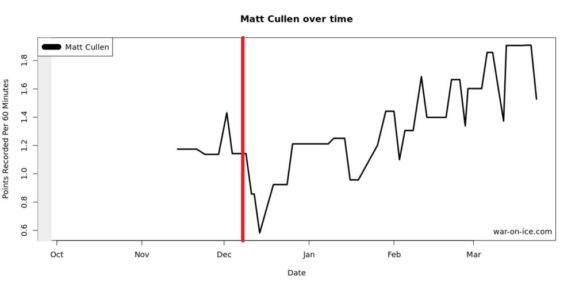In the middle of last summer I made a bold claim, the Pittsburgh Penguins signing of Matt Cullen was an “inexpensive mistake.” If you’re looking for the article it can be found right here.
My biggest concern at the time was Cullen’s age and the potential for him to stop a younger forward from seeing NHL ice time. And that stems from the Penguins history of trusting veterans and ignoring their own young players. I also doubted Cullen’s foot speed at 39-years old and was not sure his legs would last through an 82 game season.
Well, it’s time to eat a slice of humble pie as Matt Cullen has looked more like the 29-year old version of himself than a 39-year old version. He has yet to miss a game this season and with other centers like Evgeni Malkin, Nick Bonino and Eric Fehr all suffering various injuries throughout the year, he’s been a very valuable part of the team.
Matt Cullen Stabilized Penguins When They Needed it Most
Through 77 games played Cullen has 13 goals, 13 assists, for a total of 26 points, is a plus+2 skater, has blocked shots and has an even-strength Corsi For percentage of 49.9. If you want to look at his point per-game production, .34, it’s his lowest rate since the 2003-04 season.
However, here’s where things get interesting, let’s look at Cullen’s point production not by game, but per-sixty minutes played at even strength. He’s produced 1.5 points per-sixty, which is just below his career average of 1.7 points per-sixty. But his goals per-sixty is actually .8, which is tied for the second highest mark in his career.
Matt Cullen has 13 goals.
Player with fewer goals include Ryan Getzlaf, Marian Gaborik, Eric Staal, Paul Stastny and Nick Foligno.
— Seth Rorabaugh (@SethRorabaugh) March 28, 2016
The reality is that the Penguins know he’s an older player and he can’t play the same amount of minutes he did earlier in his career. This season Cullen is getting 10.5 minutes of even-strength ice time per game, which is the lowest amount since the 2005-06 season.
But like many players, Matt Cullen was hampered by Mike Johnston’s simple system early in the season. Take a look at this graphic from war-on-ice.com and look at the dramatic change in his point production per-sixty since Mike Sullivan became coach of the Penguins.

As you can imagine, the red line is where the coaching change was made. Since that point, Cullen has been producing points at a higher rate, and has a slightly improved Corsi For percentage of 50.1.
Add on that Cullen has been playing 2.5 minutes of penalty killing minutes per-game, his second highest amount of time since 2006-07 when he played 2.9 minutes on the kill. And a big part of the reason why Cullen’s overall point-production is down this season is to how he’s being used.
This season he’s played just 0.2 minutes per-game on the powerplay, now compare that to his career average of 2.6 minutes per-game and the numbers start to make sense. And he’s not playing with the highest quality of linemates either, 3.8 percent of the time he centers a line with Tom Kuhnhackl and Bryan Rust flanking him. His next most frequent linemates are Carl Hagelin and Phil Kessel, but they only have played 2.61% of the time.
This isn’t a knock on either of those players because Kuhnahackl and Rust have both been pleasant surprises and Hagelin and Kessel are known NHL commodities.
Overall, considering that Matt Cullen is playing on a one-year $800,000 contract, it’s a great value for the team. And admittedly probably the best move that general manager Jim Rutherford has made while working for the Penguins.
He’s been a stabilizer, especially with Pittsburgh’s rash of injuries down the middle and been a leader inside the locker room. From someone who doubted Cullen prior to the season, he’s absolutely proved me wrong and been one of the most inspiring story-lines with the Penguins this season.